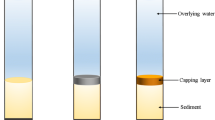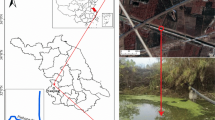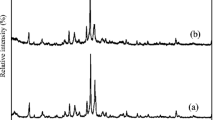Abstract
Ca(NO3)2 addition has proved to have a high potential to immobilize internal phosphorus (P) in sediments; however, it cannot effectively stop the release of ammonium-nitrogen (NH4+-N) from sediments into overlying waters (OL-waters). Additionally, the addition of Ca(NO3)2 alone has high risk of nitrate-nitrogen (NO3−-N) releasing into OL-waters. To overcome the shortcoming of the Ca(NO3)2 addition method, we reported an integrated method, i.e., a combined method based on Ca(NO3)2 injection, zeolite capping, and anion exchange resin (AERN)–contained floating system suspending (Ca(NO3)2/zeolite/AERN). The effectiveness and mechanism of the Ca(NO3)2/zeolite/AERN method for simultaneously controlling the release of soluble reactive P (SRP) and NH4+-N were investigated, and the NO3−-N releasing risk of this method was evaluated. It was found that the joint use of Ca(NO3)2 injection, zeolite capping, and AERN-contained floating system suspending not only could effectively suppress the release of SRP and NH4+-N from sediments into OL-waters simultaneously, but also had much less risk of NO3−-N releasing into OL-waters as compared to the single Ca(NO3)2 injection method and the combined Ca(NO3)2/zeolite method. The inhibition of the reductive dissolution of the P-bound Fe(III) oxides/hydroxides by the presence of nitrate and the adsorption of ammonium on the zeolite played very important roles in the interception of SRP and NH4+-N releasing into OL-waters by the Ca(NO3)2/zeolite/AERN method. After the sediment remediation using the Ca(NO3)2/zeolite/AERN approach, the increase in the content of residual P in the sediment layer of 0–50 mm, the decrease of mobile P in the sediment layer of 0–10 mm, and the increased NH4+-N adsorption capacity for the sediment layer of 0–10 mm would be conductive to the interception of SRP and NH4+-N liberation in the long run. Results of this research suggest a promising application potential of the Ca(NO3)2/zeolite/AERN method in the simultaneous control of the release of SRP and NH4+-N from sediments.










Similar content being viewed by others
Change history
19 May 2020
The correct presentation fig. 8a is presented in this paper.
Abbreviations
- P:
-
Phosphorus
- N :
-
Nitrogen
- NO3−-N:
-
Nitrate-nitrogen
- NH4+-N:
-
Ammonium-nitrogen
- SRP:
-
Soluble reactive P
- DGT:
-
Diffusion gradient in thin film
- C DGT-P :
-
Labile P determined by DGT
- C DGT-Fe :
-
Labile Fe determined by DGT
- NH4Cl-P:
-
NH4Cl-extractable P
- BD-P:
-
Sodium bicarbonate/sodium hydrosulfite mixed solution-extracted P
- NaOH-rP:
-
Sodium hydroxide solution-extracted P
- HCl-P:
-
Hydrochloric acid solution-extracted P
- Res-P:
-
Residual P
- Mob-P:
-
Mobile P
- EXPS:
-
External P source
- INPS:
-
Internal P source
- OL-water:
-
Overlying water
- Po-water:
-
Pore water
- AERN:
-
Anion-exchange resin
- 717-AERN:
-
717 anion-exchange resin
- Ca(NO3)2/zeolite/AERN:
-
Combined method based on Ca(NO3)2 injection, zeolite capping, and AERN-contained floating system suspending
- SW-F:
-
Interface of sediment and OL-water
- DO:
-
Dissolved oxygen
- CGGC:
-
China Guoyao Group Chemical Reagent Limited Company
References
Alshameri A, Ibrahim A, Assabri AM, Lei X, Wang H, Yan C (2014) The investigation into the ammonium removal performance of Yemeni natural zeolite: modification, ion exchange mechanism, and thermodynamics. Powder Technol 258:20–31
Berg U, Neumann T, Donnert D, Nüesch R, Stüben D (2004) Sediment capping in eutrophic lakes-efficiency of undisturbed calcite barriers to immobilize phosphorus. Appl Geochem 19:1759–1771
Beutel MW, Leonard TM, Dent SR, Moore BC (2008) Effects of aerobic and anaerobic conditions on P, N, Fe, Mn, and Hg accumulation in waters overlaying profundal sediments of an oligo-mesotrophic lake. Water Res 42:1953–1962
Boeykens SP, Piol MN, Samudio Legal L, Saralegui AB, Vázquez C (2017) Eutrophication decrease: phosphate adsorption processes in presence of nitrates. J Environ Manag 203:888–895
Chabani M, Amrane A, Bensmaili A (2009) Equilibrium sorption isotherms for nitrate on resin Amberlite IRA 400. J Hazard Mater 165:27–33
Chen M, Ding S, Liu L, Xu D, Han C, Zhang C (2015) Iron-coupled inactivation of phosphorus in sediments by macrozoobenthos (chironomid larvae) bioturbation: evidences from high-resolution dynamic measurements. Environ Pollut 204:241–247
Chen MS, Ding SM, Liu L, Xu D, Gong MD, Tang H, Zhang CS (2016) Kinetics of phosphorus release from sediments and its relationship with iron speciation influenced by the mussel (Corbicula fluminea) bioturbation. Sci Total Environ 542(Part A):833–840
Chen MS, Ding SM, Chen X, Sun Q, Fan XF, Lin J, Ren MY, Yang LY, Zhang CS (2018) Mechanisms driving phosphorus release during algal blooms based on hourly changes in iron and phosphorus concentrations in sediments. Water Res 133:153–164
Cheng H, Hua Z (2016) Effects of hydrodynamic disturbances and resuspension characteristics on the release of tetrabromobisphenol A from sediment. Environ Pollut 219:785–793
Cheng H, Hua Z (2018) Distribution, release and removal behaviors of tetrabromobisphenol A in water-sediment systems under prolonged hydrodynamic disturbances. Sci Total Environ 636:402–410
Cheng D, Song J, Zhao X, Wang S, Lin Q, Peng J, Su P, Deng W (2019) Effects of chironomid larvae and Limnodrilus hoffmeisteri bioturbation on the distribution and flux of chromium at the sediment-water interface. J Environ Manag 245:151–159
Ding SM, Han C, Wang YP, Yao L, Wang YY, Xu D, Sun Q, Williams PN, Zhang CS (2015) In situ, high-resolution imaging of labile phosphorus in sediments of a large eutrophic lake. Water Res 74:100–109
Ding SM, Chen MS, Cui JZ, Wang D, Lin J, Zhang CS, Tsang DCW (2018) Reactivation of phosphorus in sediments after calcium-rich mineral capping: implication for revising the laboratory testing scheme for immobilization efficiency. Chem Eng J 331:720–728
Feibicke M (1997) Impact of nitrate addition on phosphorus availability in sediment and water column and on plankton biomass-experimental field study in the shallow Brackish Schlei Fjord (Western Baltic, Germany). Water Air Soil Pollut 99:445–456
Foy RH (1986) Suppression of phosphorus release from lake sediments by the addition of nitrate. Water Res 20:1345–1351
Gerling AB, Browne RG, Gantzer PA, Mobley MH, Little JC, Carey CC (2014) First report of the successful operation of a side stream supersaturation hypolimnetic oxygenation system in a eutrophic, shallow reservoir. Water Res 67:129–143
Gu BW, Hong SH, Lee CG, Park SJ (2019) The feasibility of using bentonite, illite, and zeolite as capping materials to stabilize nutrients and interrupt their release from contaminated lake sediments. Chemosphere 219:217–226
He Z, Huang R, Liang Y, Yu G, Chong Y, Wang L (2018) Index for nitrate dosage calculation on sediment odor control using nitrate-dependent ferrous and sulfide oxidation interactions. J Environ Manag 226:289–297
Hrenovic J, Rozic M, Sekovanic L, Anic-Vucinic A (2008) Interaction of surfactant-modified zeolites and phosphate accumulating bacteria. J Hazard Mater 156:576–582
Huang HM, Xiao XM, Yan B, Yang LP (2010) Ammonium removal from aqueous solutions by using natural Chinese (Chende) zeolite as adsorbent. J Hazard Mater 175:247–252
Huser BJ, Egemose S, Harper H, Hupfer M, Jensen H, Pilgrim KM, Reitzel K, Rydin E, Futter M (2016) Longevity and effectiveness of aluminum addition to reduce sediment phosphorus release and restore lake water quality. Water Res 97:122–132
Kaiserli A, Voutsa D, Samara C (2002) Phosphorus fractionation in lake sediments – lakes Volvi and Koronia, N Greece. Chemosphere 46:1147–1155
Kobetičová K, Černý R (2019) Terrestrial eutrophication of building materials and buildings: an emerging topic in environmental studies. Sci Total Environ 689:1316–1328
Li C, Yu H, Tabassum S, Li L, Wu D, Zhang Z, Kong H, Xu P (2017) Effect of calcium silicate hydrates (CSH) on phosphorus immobilization and speciation in shallow lake sediment. Chem Eng J 317:844–853
Liboriussen L, Søndergaard M, Jeppesen E, Thorsgaard I, Grünfeld S, Jakobsen TS, Hansen K (2009) Effects of hypolimnetic oxygenation on water quality: results from five Danish lakes. Hydrobiologia 625:157–172
Lin JW, Zhan YH, Zhu ZL (2011) Evaluation of sediment capping with active barrier systems (ABS) using calcite/zeolite mixtures to simultaneously manage phosphorus and ammonium release. Sci Total Environ 409:638–646
Lin J, Qiu PH, Yan XJ, Xiong X, Jing LD, Wu CX (2015) Effectiveness and mode of action of calcium nitrate and Phoslock® in phosphorus control in contaminated sediment, a microcosm study. Water Air Soil Pollut 226:330
Lin J, Zhao Y, Zhang Z, Zhan Y, Zhang Z, Wang Y, Yu Y, Wu X (2019a) Immobilization of mobile and bioavailable phosphorus in sediments using lanthanum hydroxide and magnetite/lanthanum hydroxide composite as amendments. Sci Total Environ 687:232–243
Lin JW, He SQ, Zhang HH, Zhan YH, Zhang ZB (2019b) Effect of zirconium-modified zeolite addition on phosphorus mobilization in sediments. Sci Total Environ 646:144–157
Liu C, Zhong J, Wang J, Zhang L, Fan C (2016) Fifteen-year study of environmental dredging effect on variation of nitrogen and phosphorus exchange across the sediment-water interface of an urban lake. Environ Pollut 219:639–648
Liu XN, Tao Y, Zhou KY, Zhang QQ, Chen GY, Zhang XH (2017) Effect of water quality improvement on the remediation of river sediment due to the addition of calcium nitrate. Sci Total Environ 575:887–894
Meis S, Spears BM, Maberly SC, O’Malley MB, Perkins RG (2012) Sediment amendment with Phoslock® in Clatto reservoir (Dundee, UK): investigating changes in sediment elemental composition and phosphorus fractionation. J Environ Manag 93:185–193
Milmile SN, Pande JV, Karmakar S, Bansiwal A, Chakrabarti T, Biniwale RB (2011) Equilibrium isotherm and kinetic modeling of the adsorption of nitrates by anion exchange Indion NSSR resin. Desalination 276:38–44
Moal ML, Gascuel-Odoux C, Ménesguen A, Souchon Y, Étrillard C, Levain A, Moatar F, Pannard A, Souchu P, Lefebvre A, Pinay G (2019) Eutrophication: a new wine in an old bottle? Sci Total Environ 651:1–11
Ortiz-Reyes E, Anex RP (2018) A life cycle impact assessment method for freshwater eutrophication due to the transport of phosphorus from agricultural production. J Clean Prod 177:474–482
Ribeiro DC, Martins G, Nogueira R, Cruz JV, Brito AG (2008) Phosphorus fractionation in volcanic lake sediments (Azores – Portugal). Chemosphere 70:1256–1263
Rydin E (2000) Potentially mobile phosphorus in Lake Erken sediment. Water Res 34:2037–2042
Rydin E (2014) Inactivated phosphorus by added aluminum in Baltic Sea sediment. Estuar Coast Shelf Sci 151:181–185
Song HO, Zhou Y, Li AM, Mueller S (2012) Selective removal of nitrate from water by a macroporous strong basic anion exchange resin. Desalination 296:53–60
Stefan D-S, Frederick van Staden J, Vasile E, Vasile O-R, Dancila M (2014) Influence of sulfate and nitrate uptake from aqueous solutions on surface exchange in Purolite A-520E resin. C R Chim 17:738–745
Sun Q, Lin J, Cao J, Li C, Shi D, Gao M, Wang Y, Zhang C, Ding S (2019) A new method to overall immobilization of phosphorus in sediments through combined application of capping and oxidizing agents. Sci Total Environ 694:133770
Tu L, Jarosch KA, Schneider T, Grosjean M (2019) Phosphorus fractions in sediments and their relevance for historical lake eutrophication in the Ponte Tresa basin (Lake Lugano, Switzerland) since 1959. Sci Total Environ 685:806–817
Ulrich AE, Malley DF, Watts PD (2016) Lake Winnipeg Basin: advocacy, challenges and progress for sustainable phosphorus and eutrophication control. Sci Total Environ 542:1030–1039
Wang S, Peng Y (2010) Natural zeolites as effective adsorbents in water and wastewater treatment. Chem Eng J 156:11–24
Wang SR, Jin XC, Bu QY, Jiao LX, Wu FC (2008) Effects of dissolved oxygen supply level on phosphorus release from lake sediments. Colloid Surface A 316:245–252
Wang CH, Liang JC, Pei YS, Wendling LA (2013) A method for determining the treatment dosage of drinking water treatment residuals for effective phosphorus immobilization in sediments. Ecol Eng 60:421–427
Wang W-H, Wang Y, Li Z, Wei C-Z, Zhao J-C, L-q S (2018) Effect of a strengthened ecological floating bed on the purification of urban landscape water supplied with reclaimed water. Sci Total Environ 622-623:1630–1639
Wang Z, Huang S, Li D (2019) Decomposition of cyanobacterial bloom contributes to the formation and distribution of iron-bound phosphorus (Fe-P): insight for cycling mechanism of internal phosphorus loading. Sci Total Environ 652:696–708
Wauer G, Gonsiorczyk T, Casper P, Koschel R (2005a) P-immobilisation and phosphatase activities in lake sediment following treatment with nitrate and iron. Limnologica 35:102–108
Wauer G, Gonsiorczyk T, Kretschmer K, Casper P, Koschel R (2005b) Sediment treatment with a nitrate-storing compound to reduce phosphorus release. Water Res 39:494–500
Wu Z, Liu Y, Liang Z, Wu S, Guo H (2017) Internal cycling, not external loading, decides the nutrient limitation in eutrophic lake: a dynamic model with temporal Bayesian hierarchical inference. Water Res 116:231–240
Xie F, Dai Z, Zhu Y, Li G, Li H, He Z, Geng S, Wu F (2019) Adsorption of phosphate by sediments in a eutrophic lake: isotherms, kinetics, thermodynamics and the influence of dissolved organic matter. Colloid Surface A 562:16–25
Xu G, Sun Z, Fang W, Liu J, Xu X, Lv C (2018) Release of phosphorus from sediments under wave-induced liquefaction. Water Res 144:503–511
Yamada TM, Sueitt APE, Beraldo DAS, Botta CMR, Fadini PS, Nascimento MRL, Faria BM, Mozeto AA (2012) Calcium nitrate addition to control the internal load of phosphorus from sediments of a tropical eutrophic reservoir: microcosm experiments. Water Res 46:6463–6475
Yin HB, Kong M (2015) Reduction of sediment internal P-loading from eutrophic lakes using thermally modified calcium-rich attapulgite-based thin-layer cap. J Environ Manag 151:178–185
Yin H, Zhu J, Tang W (2018) Management of nitrogen and phosphorus internal loading from polluted river sediment using Phoslock® and modified zeolite with intensive tubificid oligochaetes bioturbation. Chem Eng J 353:46–55
Yin H, Yang P, Kong M (2019) Effects of nitrate dosing on the migration of reduced sulfur in black odorous river sediment and the influencing factors. Chem Eng J 371:516–523
Yu J, Ding S, Zhong J, Fan C, Chen Q, Yin H, Zhang L, Zhang Y (2017) Evaluation of simulated dredging to control internal phosphorus release from sediments: focused on phosphorus transfer and resupply across the sediment-water interface. Sci Total Environ 592:662–673
Yu P, Wang J, Chen J, Guo J, Yang H, Chen Q (2019) Successful control of phosphorus release from sediments using oxygen nano-bubble-modified minerals. Sci Total Environ 663:654–661
Zhan Y, Wu X, Lin J, Zhang Z, Zhao Y, Yu Y, Wang Y (2019a) Combined use of calcium nitrate addition and anion exchange resin capping to control sedimentary phosphorus release and its nitrate-nitrogen releasing risk. Sci Total Environ 689:203–214
Zhan Y, Yu Y, Lin J, Wu X, Wang Y, Zhao Y (2019b) Simultaneous control of nitrogen and phosphorus release from sediments using iron-modified zeolite as capping and amendment materials. J Environ Manag 249:109369
Zhang L, Wang S, Wu Z (2014) Coupling effect of pH and dissolved oxygen in water column on nitrogen release at water–sediment interface of Erhai Lake, China. Estuar Coast Shelf Sci 149:178–186
Zhao L, Li Y, Wang S, Wang X, Meng H, Luo S (2016) Adsorption and transformation of ammonium ion in a loose-pore geothermal reservoir: batch and column experiments. J Contam Hydrol 192:50–59
Zhu Y, Shan B, Huang J, Teasdale PR, Tang W (2019a) In situ biochar capping is feasible to control ammonia nitrogen release from sediments evaluated by DGT. Chem Eng J 374:811–821
Zhu YY, Tang WZ, Jin X, Shan BQ (2019b) Using biochar capping to reduce nitrogen release from sediments in eutrophic lakes. Sci Total Environ 646:93–104
Zou YC, Grace MR, Roberts KL, Yu XF (2017) Thin ferrihydrite sediment capping sequestrates phosphorus experiencing redox conditions in a shallow temperate lacustrine wetland. Chemosphere 185:673–680
Funding
This research was financially supported by the Shandong Key Scientific and Technical Innovation Project (2018YFJH0902), the Shanghai Natural Science Foundation (15ZR1420700), the National Science Foundation of China (50908142 and 51408354), and the Scientific Research Project of Shanghai Science and Technology Committee (10230502900).
Author information
Authors and Affiliations
Corresponding author
Additional information
Responsible Editor: Philippe Garrigues
Publisher’s note
Springer Nature remains neutral with regard to jurisdictional claims in published maps and institutional affiliations.
The original article was revised: The correct presentation figure 8a is presented in this paper.
Rights and permissions
About this article
Cite this article
Zhan, Y., Wu, X. & Lin, J. Combined use of calcium nitrate, zeolite, and anion exchange resin for controlling phosphorus and nitrogen release from sediment and for overcoming disadvantage of calcium nitrate addition technology. Environ Sci Pollut Res 27, 24863–24878 (2020). https://doi.org/10.1007/s11356-020-08850-w
Received:
Accepted:
Published:
Issue Date:
DOI: https://doi.org/10.1007/s11356-020-08850-w




